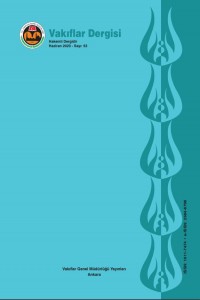Abstract
In this study, a prayer book in Amasya Province Public Library is examined with its appearance, text content and illustrations. It is seen that this manuscript also includes the prayer books of the 18th and 19th centuries and the city depictions of Mecca and Medina, which are frequently encountered in the Delâilü'l-Hayrât. Unlike classical era miniatures in the period, these depictions have applications such as perspective, third dimension and color tones. Unlike other prayer books, this work is important to include the characteristics of Prophet Muhammad and the four caliphs in the form of hilya and to depict kadam sharif and dhulfaqar. In addition to the protective verse and prayers in the work, it is also noteworthy that it contains the names of Prophet Muhammad and Ashab al-Kahf.
References
- Arık, Rüçhan (1975). Batılılaşma Dönemi Anadolu Tasvir Sanatı, Kültür ve Turizm Bakanlığı Yayınları.Bağcı, Serpil ve Filiz Çağman, Günsel Renda, Zeren Tanındı (2012). Osmanlı Resim Sanatı, Ankara: Kültür ve Turizm Bakanlığı Yayınları.Bozkurt, Nebi (2001). “Kadem-i Şerif”, Diyanet Vakfı İslam Ansiklopedisi, C. 24, s. 57.Bozkurt, Nebi, Küçükaşçı, M. Sabri (2004). “Mescid-i Harâm”, Diyanet Vakfı İslam Ansiklopedisi, C. 29, s. 273-276. Çerçi, Faris (2015). “Hz. Peygamber’in Doksan Dokuz İsmi”, Erzincan Üniversitesi Sosyal Bilimler Enstitüsü Dergisi, C. 9, S. 1, s. 17-37.Derman, M. Uğur (1977). Türk Sanatında Ebru, Ak Yayınları.Derman, M. Uğur (1998). “Hilye (Hat)”, Diyanet Vakfı İslam Ansiklopedisi, C. 18, s. 47. Doğanay, Aziz (2004). “Türk Sanatında Pelengî ve Şâhî Benek Nakışları ya da Çintamani Yanılgısı”, Dîvân İlmî Araştırmalar, S. 17, s. 193-218.Ersoy, Ayla (1988). Türk Tezhip Sanatı, İstanbul: Ak Yayınları.Gülgen, Hicabi ve Semra Güler (2018). “Osmanlı Devleti’nde Klasik Dönem ve Sonrasına Ait Delâilü’l-Hayrât Minyatürlerindeki Değişim”, İslam Medeniyeti Araştırmaları Dergisi, C. 3, S. 1, s. 31, 41-44.Özkeçeci, İlhan ve Ş. Bilge Özkeçeci (2007). Türk Sanatında Tezhip, İstanbul.Öztürk, Necati (2007). Fotoğraflarla Kutsal Topraklar Hicaz Albümü, (ed. Ahmet Özel), Ankara: Diyanet İşleri Başkanlığı Yayınları.Paksoy, Kadir (2011). “Allah’ın Doksan Dokuz İsmiyle İlgili Rivayetin Tahlili”, Din Bilimleri Akademik Araştırma Dergisi, C. 11, S. 1, s. 91-111.Renda, Günsel (1977) Batılılaşma Döneminde Türk Resim Sanatı 1700-1850, Ankara: Hacattepe Üniversitesi Yayınları.Turan, Hayrunnisa (2018). “Kudüs ve Yafa’daki Bazı Örnekler Işığında Osmanlı Tılsımları”, Uluslararası Sosyal Araştırmalar Dergisi, C. 11, S. 55, s. 423-429. Uzun, Mustafa (1998). “Hilye”, Diyanet Vakfı İslam Ansiklopedisi, C. 18, s. 44. http://www.yazmalar.gov.tr/eser/mecm%C3%BBa-i-ed%C3%AEye/5508 (09.07.2019).https://digital.staatsbibliothek-berlin.de/werkansicht?PPN=PPN767853555&PHYSID=PHYS_0012&DMDID=DMDLOG_0001 (11.07.2019).https://digital.staatsbibliothek-berlin.de/werkansicht?PPN=PPN767853555&PHYSID=PHYS_0013&DMDID=DMDLOG_0001 (11.07.2019).https://digital.staatsbibliothek-berlin.de/werkansicht?PPN=PPN767853555&PHYSID=PHYS_0014&DMDID=DMDLOG_0001 (11.07.2019).https://digital.staatsbibliothek-berlin.de/werkansicht?PPN=PPN767853555&PHYSID=PHYS_0015&DMDID=DMDLOG_0001 (11.07.2019).https://digital.staatsbibliothek-berlin.de/werkansicht?PPN=PPN767853555&PHYSID=PHYS_0016&DMDID=DMDLOG_0001 (11.07.2019).
Abstract
Bu çalışmada Amasya Bayezıt İl Halk Kütüphanesi’nde
yer alan bir dua mecmuası dış görünümü, metin içeriği ve tasvirleri açısından
incelenmektedir. 18. ve 19. yüzyıllara ait dua kitapları ile Delâilü’l-Hayrât’larda
sıklıkla karşılaşılan Mekke ve Medine şehir tasvirlerini bu eserin de ihtiva
ettiği görülmektedir. Dönem itibariyle klasik dönem minyatürlerinden farklı
olarak bu tasvirlerde perspektif, üçüncü boyut ve renk tonlamaları gibi
uygulamalara rastlanmaktadır. Diğer dua kitaplarından farklı olarak ise eserde,
hilye formuyla Hz. Muhammed ve dört halifenin vasıflarına yer verilmesi ve
kadem-i şerif ile zülfikar tasvirlerinin bulunması önem arz etmektedir. Ayrıca
eserin, koruyucu nitelikli sûre ve dualara ilaveten Allah’ın doksan dokuz ismi
ile Hz. Muhammed’in ve Ashab-ı Kehf’in isimlerini içermesi de dikkat
çekmektedir.
References
- Arık, Rüçhan (1975). Batılılaşma Dönemi Anadolu Tasvir Sanatı, Kültür ve Turizm Bakanlığı Yayınları.Bağcı, Serpil ve Filiz Çağman, Günsel Renda, Zeren Tanındı (2012). Osmanlı Resim Sanatı, Ankara: Kültür ve Turizm Bakanlığı Yayınları.Bozkurt, Nebi (2001). “Kadem-i Şerif”, Diyanet Vakfı İslam Ansiklopedisi, C. 24, s. 57.Bozkurt, Nebi, Küçükaşçı, M. Sabri (2004). “Mescid-i Harâm”, Diyanet Vakfı İslam Ansiklopedisi, C. 29, s. 273-276. Çerçi, Faris (2015). “Hz. Peygamber’in Doksan Dokuz İsmi”, Erzincan Üniversitesi Sosyal Bilimler Enstitüsü Dergisi, C. 9, S. 1, s. 17-37.Derman, M. Uğur (1977). Türk Sanatında Ebru, Ak Yayınları.Derman, M. Uğur (1998). “Hilye (Hat)”, Diyanet Vakfı İslam Ansiklopedisi, C. 18, s. 47. Doğanay, Aziz (2004). “Türk Sanatında Pelengî ve Şâhî Benek Nakışları ya da Çintamani Yanılgısı”, Dîvân İlmî Araştırmalar, S. 17, s. 193-218.Ersoy, Ayla (1988). Türk Tezhip Sanatı, İstanbul: Ak Yayınları.Gülgen, Hicabi ve Semra Güler (2018). “Osmanlı Devleti’nde Klasik Dönem ve Sonrasına Ait Delâilü’l-Hayrât Minyatürlerindeki Değişim”, İslam Medeniyeti Araştırmaları Dergisi, C. 3, S. 1, s. 31, 41-44.Özkeçeci, İlhan ve Ş. Bilge Özkeçeci (2007). Türk Sanatında Tezhip, İstanbul.Öztürk, Necati (2007). Fotoğraflarla Kutsal Topraklar Hicaz Albümü, (ed. Ahmet Özel), Ankara: Diyanet İşleri Başkanlığı Yayınları.Paksoy, Kadir (2011). “Allah’ın Doksan Dokuz İsmiyle İlgili Rivayetin Tahlili”, Din Bilimleri Akademik Araştırma Dergisi, C. 11, S. 1, s. 91-111.Renda, Günsel (1977) Batılılaşma Döneminde Türk Resim Sanatı 1700-1850, Ankara: Hacattepe Üniversitesi Yayınları.Turan, Hayrunnisa (2018). “Kudüs ve Yafa’daki Bazı Örnekler Işığında Osmanlı Tılsımları”, Uluslararası Sosyal Araştırmalar Dergisi, C. 11, S. 55, s. 423-429. Uzun, Mustafa (1998). “Hilye”, Diyanet Vakfı İslam Ansiklopedisi, C. 18, s. 44. http://www.yazmalar.gov.tr/eser/mecm%C3%BBa-i-ed%C3%AEye/5508 (09.07.2019).https://digital.staatsbibliothek-berlin.de/werkansicht?PPN=PPN767853555&PHYSID=PHYS_0012&DMDID=DMDLOG_0001 (11.07.2019).https://digital.staatsbibliothek-berlin.de/werkansicht?PPN=PPN767853555&PHYSID=PHYS_0013&DMDID=DMDLOG_0001 (11.07.2019).https://digital.staatsbibliothek-berlin.de/werkansicht?PPN=PPN767853555&PHYSID=PHYS_0014&DMDID=DMDLOG_0001 (11.07.2019).https://digital.staatsbibliothek-berlin.de/werkansicht?PPN=PPN767853555&PHYSID=PHYS_0015&DMDID=DMDLOG_0001 (11.07.2019).https://digital.staatsbibliothek-berlin.de/werkansicht?PPN=PPN767853555&PHYSID=PHYS_0016&DMDID=DMDLOG_0001 (11.07.2019).
Details
| Primary Language | Turkish |
|---|---|
| Journal Section | Articles |
| Authors | |
| Publication Date | June 30, 2020 |
| Submission Date | July 12, 2019 |
| Acceptance Date | February 10, 2020 |
| Published in Issue | Year 2020 Issue: 53 |
The articles sent to the Journal of Waqfs with a request for publication are subject to preliminary examination by the Editorial Board and at least two academicians who are experts in their fields are sent for review. The copyright of the articles accepted to be published in the Journal of Waqfs with the referee reports and the decision of the Editorial Board is deemed to have been transferred to the General Directorate of Foundations, and a royalty fee is paid to the published articles in accordance with the relevant legislation.


